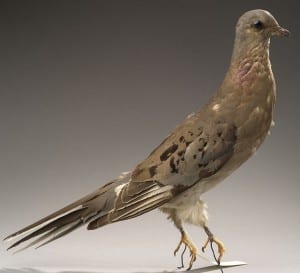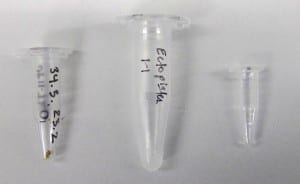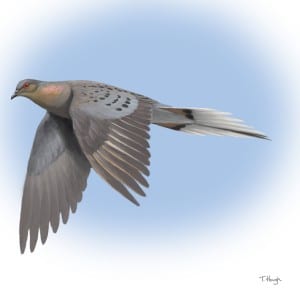by Ben Novak
In 1871 along the east shore of the Don River, a Canadian named William S. W. Grainger witnessed a flock of North America’s most common birds: passenger pigeons. As Grainger harvested a decent female pigeon from the flock that day he probably didn’t think the species could ever go extinct. The passenger pigeon numbered in the billions from the time he was a child all the way until this hunting expedition in the woods, that would later become the greater metropolitan area of Toronto.
The people of Toronto had often seen flocks that seemed endless along the shores of Lake Ontario, flying overhead for hours and even days. The passenger pigeon roosted and bred throughout the lower Ontario peninsula from Niagara Falls to Windsor. The trees of every roost for decades were practically blue with pigeons for miles into the deepest woods. But Ontario’s deep history with the passenger pigeon doesn’t end with these long forgotten scenes.
The bird Grainger collected that day would wind up a taxidermy specimen with little thought given to any potential significance, until September 1st, 1914 when the billions that Grainger had known his whole life had been gone for twenty years… and Martha, the last remaining bird of her species, died marking the extinction of the world’s mightiest flocks.

The 1871 passenger pigeon specimen whose DNA is being used for The Great Comeback. Photo credit: Brian Boyle,
Royal Ontario Museum.
Years later, Paul Hahn, a man who could be considered quite obsessed with passenger pigeon specimens set out to document every passenger pigeon specimen that had ever been collected, and if he could to collect the specimens personally. Hahn collected dozens of specimens during the 1920’s and one of them just so happened to be that female bird taken by Grainger nearly half a century earlier. Extinction, which was far from Grainger’s mind, was now all that could be thought when looking at this female bird, faded and stuffed with cotton. Hahn donated all the specimens he found to the Royal Ontario Museum (ROM). By the 1930’s Graingers bird had cataloged as ROM 34.3.23.2, and joined what would become the world’s largest collection of passenger pigeon specimens.
And over the years as ROM 34.3.23.2 gathered dust in a museum drawer the world around her changed The Computer was invented and the double helix of DNA was deciphered. Hahn and Grainger wouldn’t have even fathomed genetics and the science fiction that would ensue, but they are as tied to the present as I am.
In 2010 Dr. Beth Shapiro, Associate Professor of Ecology and Evolutionary Biology at UC Santa Cruz, produced the first large data set of DNA from nine test subject passenger pigeons from the ROM collections. The results were encouraging, prompting her to gather more tissue samples from well-documented specimens throughout 2010-2011 from the ROM collection, which would include ROM 34.3.23.2. All of these specimens were (and are) in the care of Dr. Allan Baker, Curator of Ornithology at the ROM.
Dr. Shapiro had become an expert in working with “paleogenomics,” the study of extinct and old DNA, through an amazing career that included the first traces of passenger pigeon DNA sequenced at Oxford University and published in 2002. That spark of data ignited her interest in pursuing the study of the population genetics of the passenger pigeon. Her pursuit was to uncover information about how the biggest flocks in the world not only went extinct so swiftly, but formed in the first place. Did the flocks of billions aggregate after the ice age? Did changing forests affect passenger pigeons? What living pigeons were the passenger pigeons related to? Just how much like living pigeons are passenger pigeons? Dr. Baker surmised the DNA hidden in the study skins of the ROM collection could hold the answers to Beth’s questions .
And then I join the narrative of Grainger, Hahn, Shapiro, and Baker, as the scientist tasked by Revive & Restore to decipher the full genetic code of the passenger pigeon and use it to do something only science fiction has played at: bring the bird back to life. No matter what the goal or the questions posed, we all needed the same thing: a passenger pigeon genome. Museum tissues hadn’t yielded much success with DNA sequencing, but new technologies were changing that. The Illumina Next Generation Sequencing machines have made the data needed to decode extinct genomes, from the Neanderthals to Mammoths, retrievable in quantities the field of paleo-genomics had never seen before.

An example of passenger pigeon tissue prepared for sequencing (left), a DNA extract, and an illumina library DNA prep.
ROM 34.3.23.2 has been known to me as a pinhead size of tissue cut from the foot of the specimen. Along with 52 other specimens from the ROM and more from other institutions I began the tedious work of extracting DNA in April of 2013. In the accumulation of test tubes follow in the lab work, ROM 34.3.23.2 became designated as BN1-1 (Ben Novak’s extraction set 1 specimen 1). After the 24 hours of tissue preparation – step one of the protocol – we all hoped the tiny tube of clear liquid contained bits of floating DNA,. Testing the presence of DNA was frustrating. The PCR tests failed a lot for many reasons and the entire lab got their gray matter working on solutions. Eventually we got the PCR recipe right; some specimens passed the test and others failed. BN1-1 revealed positive test results before any other specimen. At each step of preparing DNA for sequencing, some specimens would prove unusable. This is typical for ancient DNA samples. The DNA is in very small amounts and over time has become fragmented. A fragment in the DNA extraction may test positive for PCR, but the fragment may not be viable for sequencing due to degradation.
On September 13, 2013, 34 specimens, including BN1-1, were pooled together for a test run of sequencing – yielding the codes of DNA fragments from every bacteria, fungus, and human cell that ever touched the tissue samples in the last 150 years… and just maybe some pigeon DNA too. From this set of 34 pigeons our group was hoping to choose the best one, the one with the highest quality DNA, to assemble the reference genome of the species.
Enter André Soares, a post doc joining the UCSC Paleogenomics lab to study the population genetics of extinct species. And what better species than the passenger pigeon?! With the magic computing hands of Dr. Richard E. Green (aka Ed) the three of us began sorting through the DNA, mapping fragments to the common rock pigeon genome and calculating how much DNA was pigeon and how much was ‘everything else’. In the past ancient DNA samples have been 99% bacteria DNA and 1% extinct animal, while some astounding fossils or tissues had more than 50% extinct animal DNA. Of 34 passenger pigeons, we hit the ancient DNA lottery. 16 specimens contained 50% pigeon DNA or higher. From this set we didn’t have just one “winner”. We had our pick of dates to the Prom! The top four were all tied at a whopping 64% pigeon DNA. From these samples, we could get enough DNA to map the full genome of the species. This was the moment we’ve been waiting for, and the mood has been quite triumphant in the lab. In a matter of just a few weeks we will have all the data we need for every question that was once just a “funny thought” in a conversation between academics and enthusiasts. It’s pretty damn cool.

Female passenger pigeon. Painting by Tim Hough.
It probably doesn’t take much to guess that BN1-1 is the specimen that exceeded the others. Not only is the amount of pigeon DNA so high, but the DNA fragments are longer on average than the other top choices. She was shot when the birds were still populated in the billions, which means she’ll represent the typical pigeon of the species, and not some inbred or impoverished straggler trying to survive the pressures of industrial era harvest. BN1-1 is female, meaning she carries the sex chromosome, the W chromosome, and thus will give us the complete genome that males cannot. You may remember learning about the Y chromosome in human males, the chromosome that determines if you’re a boy, or in it’s absence if you become a girl. In birds it’s the opposite way. The females are the determining sex.
So the stage is set. The actors have all played their part to unveil the grand finale. But this show is not ours. The calculated analysis is not the property of André Soares and Ed Green. The DNA sequences and extraction of BN1-1 do not belong to me. The tissue sample is not Beth Shapiro’s. ROM 34.3.23.2 does not belong to Allan Baker. It is not Paul Hahn’s donation, nor William Grainger’s trophy. Every act of this great play is yours, the audience. In the coming months this bird will set the genome standard reference for an entire species lost in time. This genome will pave the way for a new future of conservation biology. It belongs to every generation that witnessed these great birds in life, as much as every generation that has never known them. But most importantly this genome is for a world that will see these birds fly again – all made possible from DNA hidden away in a seemingly ordinary specimen for the last 142 years.



